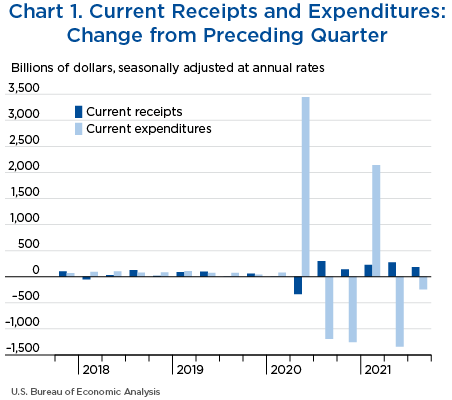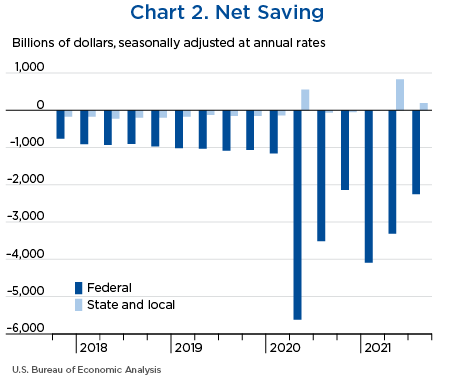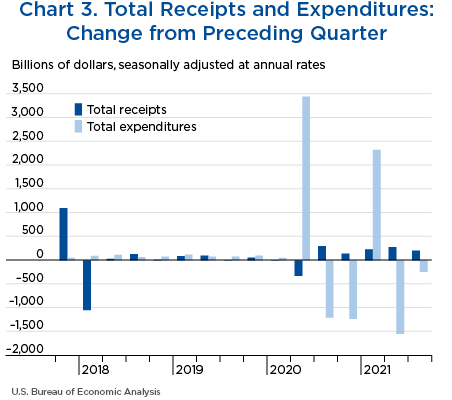Government Receipts and Expenditures
Third Quarter of 2021
Net government saving, the difference between current receipts and current expenditures in the federal government and state and local governments, was −$2,057.1 billion in the third quarter of 2021, increasing $426.9 billion from −$2,484.0 billion in the second quarter of 2021 (charts 1 and 2 and table 1).
“Net lending or net borrowing (−)” is an alternative measure of the government fiscal position. Net borrowing is the financing requirement of the government sector, and it is derived as net government saving plus the consumption of fixed capital and net capital transfers received less gross investment and net purchases of nonproduced assets.
Net borrowing was $2,199.6 billion in the third quarter, decreasing $441.8 billion from $2,641.4 billion in the second quarter (charts 3 and 4 and table 1).
| Line | Level | Change from preceding quarter | ||||
|---|---|---|---|---|---|---|
| 2021 | 2020 | 2021 | ||||
| III | IV | I | II | III | ||
| 1 | Current receipts | 6,763.0 | 141.1 | 229.5 | 275.2 | 186.0 |
| 2 | Current expenditures | 8,820.1 | −1,253.2 | 2,141.9 | −1,341.6 | −240.8 |
| 3 | Net government saving | −2,057.1 | 1,394.3 | −1,912.3 | 1,616.6 | 426.9 |
| 4 | Federal | −2,249.9 | 1,376.2 | −1,948.8 | 776.2 | 1,062.8 |
| 5 | State and local | 192.8 | 18.1 | 36.4 | 840.5 | −635.9 |
| 6 | Net lending or net borrowing (−) | −2,199.6 | 1,375.3 | −2,088.2 | 1,821.0 | 441.8 |
| 7 | Federal | −2,352.9 | 1,368.5 | −2,134.0 | 964.5 | 1,066.3 |
| 8 | State and local | 153.3 | 6.8 | 45.8 | 856.6 | −624.6 |
Net federal government saving was −$2,249.9 billion in the third quarter, increasing $1,062.8 billion from −$3,312.7 billion in the second quarter (table 2). In the third quarter, current receipts decelerated and current expenditures decreased more.
Federal government net borrowing was $2,352.9 billion in the third quarter, decreasing $1,066.3 billion from $3,419.2 billion in the second quarter.
- Personal current taxes (line 3) continued to decelerate in the third quarter, reflecting a deceleration in both withheld taxes and nonwithheld taxes. The deceleration in withheld taxes reflects the pattern of wages. The deceleration in nonwithheld taxes reflects a deceleration in nonwage income.
- Taxes on production and imports (line 4) turned down in the third quarter, reflecting downturns in customs duties and excise taxes. Within excise taxes, gasoline excise taxes and alcoholic beverage excise taxes turned down.
- Taxes on corporate income (line 5) decelerated in the third quarter, reflecting a deceleration in corporate profits.
- Contributions for government social insurance (line 7) decelerated in the third quarter, reflecting the pattern of wages. Contributions for FICA (Federal Insurance Contributions Act) by employers, employees, and the self-employed decelerated.
- Income receipts on assets (line 8) decelerated in the third quarter, reflecting a deceleration in dividends from the Federal Reserve banks and a downturn in interest receipts. The downturn in interest receipts reflects a downturn in interest received from the rest of the world.
- Current transfer receipts (line 9) decreased less in the third quarter, reflecting smaller decreases in current transfer receipts from the rest of the world and current transfer receipts from business.
- Government social benefits to persons (line 17) decreased less in the third quarter, decreasing $235.7 billion after decreasing $1.7 trillion in the second quarter. The smaller decrease in the third quarter reflects a smaller decrease in economic impact payments to individuals initially authorized by the Coronavirus Aid, Relief, and Economic Security (CARES) Act, extended by the Coronavirus Response and Relief Supplemental Appropriations (CRRSA) Act, and continued in the American Rescue Plan Act. Unemployment benefits decreased more, reflecting a decrease in the temporary weekly supplemental payment of $300 to persons receiving unemployment benefits, which expired on September 4. Supplemental Nutrition Assistance Program benefits decelerated in the third quarter. These decreases were partially offset by the child tax credit prepayments that began in July; these prepayments, which are scheduled for the remainder of 2021, were enacted by the American Rescue Plan Act. Transfers to nonprofits turned up, reflecting an upturn in transfers from the Public Health and Social Services Emergency Fund.
- Grants-in-aid to state and local governments (line 20) turned down in the third quarter, reflecting the pattern of spending for various COVID-19 response efforts appropriated through the CRRSA Act and the American Rescue Plan Act. General economic and labor affairs grants turned down, reflecting decreased funding from the Coronavirus State and Local Fiscal Recovery Funds to help state and local governments bridge budget shortfalls. Education grants decelerated, reflecting decreased spending from the Education Stabilization Fund to support COVID-19 response activities in schools. Welfare and social services grants also decelerated in the third quarter, reflecting a deceleration in the payments to states for the Child Care and Development Block Grant Act.
- Other current transfer payments to the rest of the world (line 21) turned up, reflecting a $2.0 billion ($8.0 billion at an annual rate) payment to COVAX for the international effort to vaccinate against COVID-19, $1.5 billion ($6.0 billion at an annual rate) to the Global Fund to Fight AIDS, Tuberculosis and Malaria, and $0.7 billion ($2.8 billion at an annual rate) in economic support payments to the country of Jordan.
- Interest payments (line 22) accelerated, reflecting an acceleration in interest paid on treasury inflation protected securities.
- Subsidies (line 23) turned down in the third quarter, reflecting a decrease in funds appropriated through the CARES Act. Notably, Paycheck Protection Program (PPP) loans to businesses turned down. Second-quarter loans were boosted by a new round of PPP loans authorized by the CSSRA. Air carrier subsides turned down, reflecting a decrease in payroll support payments to airlines. Agricultural subsidies turned down in the third quarter, reflecting a decrease in payments to farmers from the Coronavirus Food Assistance Program as well as PPP loans to farmers. Economic injury disaster loans turned down, reflecting decreased loans to small businesses affected by the pandemic. These downturns were partially offset by an upturn in subsidies related to the Public Health and Social Service Emergency Fund. Emergency grants to closed entertainment venues and restaurant revitalization subsidies both accelerated in the third quarter; these funds were established in the second quarter and provide emergency assistance to eligible venues and restaurants affected by the pandemic.
- Capital transfer payments (line 33) turned up in the third quarter, reflecting disaster-related National Flood Insurance Program payments for insurance settlements related to Hurricane Ida.
| Line | Level | Change from preceding quarter | ||||
|---|---|---|---|---|---|---|
| 2021 | 2020 | 2021 | ||||
| III | IV | I | II | III | ||
| 1 | Current receipts | 4,310.9 | 124.6 | 167.5 | 195.2 | 133.1 |
| 2 | Current tax receipts | 2,515.4 | 95.2 | 147.0 | 134.3 | 87.1 |
| 3 | Personal current taxes | 2,019.3 | 74.7 | 115.0 | 94.2 | 73.2 |
| 4 | Taxes on production and imports | 173.0 | 5.3 | 9.6 | 11.6 | −4.8 |
| 5 | Taxes on corporate income | 293.1 | 13.4 | 21.3 | 28.7 | 18.0 |
| 6 | Taxes from the rest of the world | 30.0 | 1.7 | 1.1 | −0.1 | 0.7 |
| 7 | Contributions for government social insurance | 1,591.1 | 42.2 | 31.9 | 37.8 | 35.4 |
| 8 | Income receipts on assets | 150.3 | −16.1 | −6.8 | 29.5 | 11.3 |
| 9 | Current transfer receipts | 55.6 | 4.0 | −3.8 | −6.1 | −1.1 |
| 10 | Current surplus of government enterprises | −1.5 | −0.6 | −0.8 | −0.3 | 0.4 |
| 11 | Current expenditures | 6,560.8 | −1,251.6 | 2,116.2 | −580.9 | −929.7 |
| 12 | Consumption expenditures | 1,196.4 | −5.3 | 55.8 | −11.8 | −11.7 |
| 13 | National defense | 710.3 | 10.5 | −6.1 | 2.6 | 0.3 |
| 14 | Nondefense | 486.0 | −15.8 | 62.0 | −14.5 | −12.1 |
| 15 | Current transfer payments | 4,298.4 | −634.5 | 2,284.3 | −863.7 | −783.1 |
| 16 | Government social benefits | 3,164.9 | −636.0 | 2,240.1 | −1,705.7 | −236.8 |
| 17 | To persons | 3,136.6 | −629.2 | 2,231.5 | −1,698.3 | −235.7 |
| 18 | To the rest of the world | 28.3 | −6.8 | 8.6 | −7.4 | −1.1 |
| 19 | Other current transfer payments | 1,133.5 | 1.4 | 44.4 | 842.0 | −546.4 |
| 20 | Grants-in-aid to state and local governments | 1,057.1 | 4.5 | 38.5 | 850.7 | −575.1 |
| 21 | To the rest of the world | 76.4 | −3.1 | 5.9 | −8.7 | 28.7 |
| 22 | Interest payments | 511.6 | −9.8 | −9.2 | 1.3 | 7.8 |
| 23 | Subsidies | 554.4 | −601.9 | −214.8 | 293.2 | −142.6 |
| 24 | Net federal government saving | −2,249.9 | 1,376.2 | −1,948.8 | 776.2 | 1,062.8 |
| 25 | Social insurance funds | −604.0 | 518.0 | −244.9 | 119.8 | 225.1 |
| 26 | Other | −1,645.9 | 858.2 | −1,703.9 | 656.4 | 837.7 |
| Addenda: | ||||||
| 27 | Total receipts | 4,333.4 | 124.7 | 168.2 | 195.8 | 134.6 |
| 28 | Current receipts | 4,310.9 | 124.6 | 167.5 | 195.2 | 133.1 |
| 29 | Capital transfer receipts | 22.5 | −0.1 | 0.9 | 0.5 | 1.5 |
| 30 | Total expenditures | 6,686.3 | −1,243.8 | 2,302.2 | −768.6 | −931.8 |
| 31 | Current expenditures | 6,560.8 | −1,251.6 | 2,116.2 | −580.9 | −929.7 |
| 32 | Gross government investment | 365.6 | 2.5 | 0.5 | 6.4 | 10.5 |
| 33 | Capital transfer payments | 100.6 | −1.7 | 207.3 | −207.8 | 10.7 |
| 34 | Net purchases of nonproduced assets | −18.2 | 10.9 | −18.1 | 18.0 | −17.9 |
| 35 | Less: Consumption of fixed capital | 322.5 | 4.1 | 3.5 | 4.4 | 5.4 |
| 36 | Net lending or net borrowing (−) | −2,352.9 | 1,368.5 | −2,134.0 | 964.5 | 1,066.3 |
Net state and local government saving was $192.8 billion in the third quarter, decreasing $635.9 from $828.7 billion in the second quarter. In the third quarter, current receipts turned down and current expenditures accelerated (table 3).
State and local government net lending was $153.3 billion in the third quarter, decreasing $624.6 billion from $777.9 billion in the second quarter.
- Personal current taxes (line 3) decelerated in the third quarter, reflecting a deceleration in income taxes.
- Taxes on production and imports (line 4) decelerated in the third quarter, reflecting decelerations in sales taxes and in excise taxes.
- Taxes on corporate income (line 5) turned down in the third quarter, reflecting a deceleration in corporate profits.
- Federal grants-in-aid (line 9) turned down in the third quarter, reflecting the pattern of spending for various COVID-19 response efforts appropriated through the CRRSA Act and the American Rescue Plan Act. General economic and labor affairs grants turned down, reflecting decreased funding from the Coronavirus State and Local Fiscal Recovery Funds to help state and local governments bridge budget shortfalls. Education grants decelerated, reflecting decreased spending from the Education Stabilization Fund to support COVID-19 response activities in schools. Welfare and social services grants also decelerated in the third quarter, reflecting a deceleration in the payments to states for the Child Care and Development Block Grant Act.
- Current surplus of government enterprises (line 11) accelerated in the third quarter, reflecting an increase in federal subsidies to mass transit enterprises.
- Consumption expenditures (line 13) accelerated in the third quarter, reflecting an acceleration in compensation of general government employees.
- Government social benefits (line 14) accelerated in the third quarter, reflecting an acceleration in Medicaid benefits. The acceleration reflects higher enrollment from expanded coverage in several states, as well as the implementation of the special enrollment period for the federal Affordable Care Act Marketplace that was in place from February 15 through August 15, 2021.
- Subsidies (line 16) turned down in the third quarter, reflecting the end of the Golden State Stimulus program, which provided grants to small businesses impacted by the pandemic in California.
- Capital transfer receipts (line 22) accelerated in the third quarter, reflecting an increase in disaster-related insurance benefits related to Hurricane Ida.
| Line | Level | Change from preceding quarter | ||||
|---|---|---|---|---|---|---|
| 2021 | 2020 | 2021 | ||||
| III | IV | I | II | III | ||
| 1 | Current receipts | 3,509.2 | 21.0 | 100.5 | 930.7 | −522.2 |
| 2 | Current tax receipts | 2,179.9 | 12.9 | 57.5 | 77.3 | 43.1 |
| 3 | Personal current taxes | 599.9 | 3.2 | 37.4 | 26.2 | 13.5 |
| 4 | Taxes on production and imports | 1,488.6 | 7.7 | 13.5 | 44.6 | 30.1 |
| 5 | Taxes on corporate income | 91.4 | 2.0 | 6.7 | 6.4 | −0.5 |
| 6 | Contributions for government social insurance | 22.5 | 0.6 | 0.7 | 0.7 | 0.6 |
| 7 | Income receipts on assets | 98.1 | 1.2 | 0.4 | 0.3 | 0.1 |
| 8 | Current transfer receipts | 1,213.8 | 6.0 | 42.2 | 848.2 | −574.3 |
| 9 | Federal grants-in-aid | 1,057.1 | 4.5 | 38.5 | 850.7 | −575.1 |
| 10 | Other | 156.7 | 1.5 | 3.7 | −2.5 | 0.8 |
| 11 | Current surplus of government enterprises | −5.1 | 0.2 | −0.3 | 4.1 | 8.4 |
| 12 | Current expenditures | 3,316.4 | 2.9 | 64.1 | 90.2 | 113.7 |
| 13 | Consumption expenditures | 2,079.7 | 14.8 | 41.8 | 48.8 | 64.4 |
| 14 | Government social benefits | 944.3 | −11.1 | 18.9 | 35.5 | 58.8 |
| 15 | Interest payments | 291.8 | −0.9 | 1.5 | −0.1 | −1.5 |
| 16 | Subsidies | 0.6 | 0.0 | 1.9 | 6.1 | −8.0 |
| 17 | Net state and local government saving | 192.8 | 18.1 | 36.4 | 840.5 | −635.9 |
| 18 | Social insurance funds | 5.3 | 0.4 | 0.5 | 0.6 | 0.5 |
| 19 | Other | 187.5 | 17.7 | 35.9 | 839.9 | −636.4 |
| Addenda: | ||||||
| 20 | Total receipts | 3,601.3 | 19.1 | 99.0 | 933.6 | −514.2 |
| 21 | Current receipts | 3,509.2 | 21.0 | 100.5 | 930.7 | −522.2 |
| 22 | Capital transfer receipts | 92.1 | −1.7 | −1.6 | 2.9 | 8.0 |
| 23 | Total expenditures | 3,448.0 | 12.3 | 53.2 | 77.0 | 110.4 |
| 24 | Current expenditures | 3,316.4 | 2.9 | 64.1 | 90.2 | 113.7 |
| 25 | Gross government investment | 442.0 | 11.7 | −6.1 | −4.9 | 4.7 |
| 26 | Capital transfer payments | |||||
| 27 | Net purchases of nonproduced assets | 18.6 | 0.3 | 0.2 | 0.3 | 0.4 |
| 28 | Less: Consumption of fixed capital | 328.9 | 2.4 | 5.1 | 8.7 | 8.2 |
| 29 | Net lending or net borrowing (−) | 153.3 | 6.8 | 45.8 | 856.6 | −624.6 |



